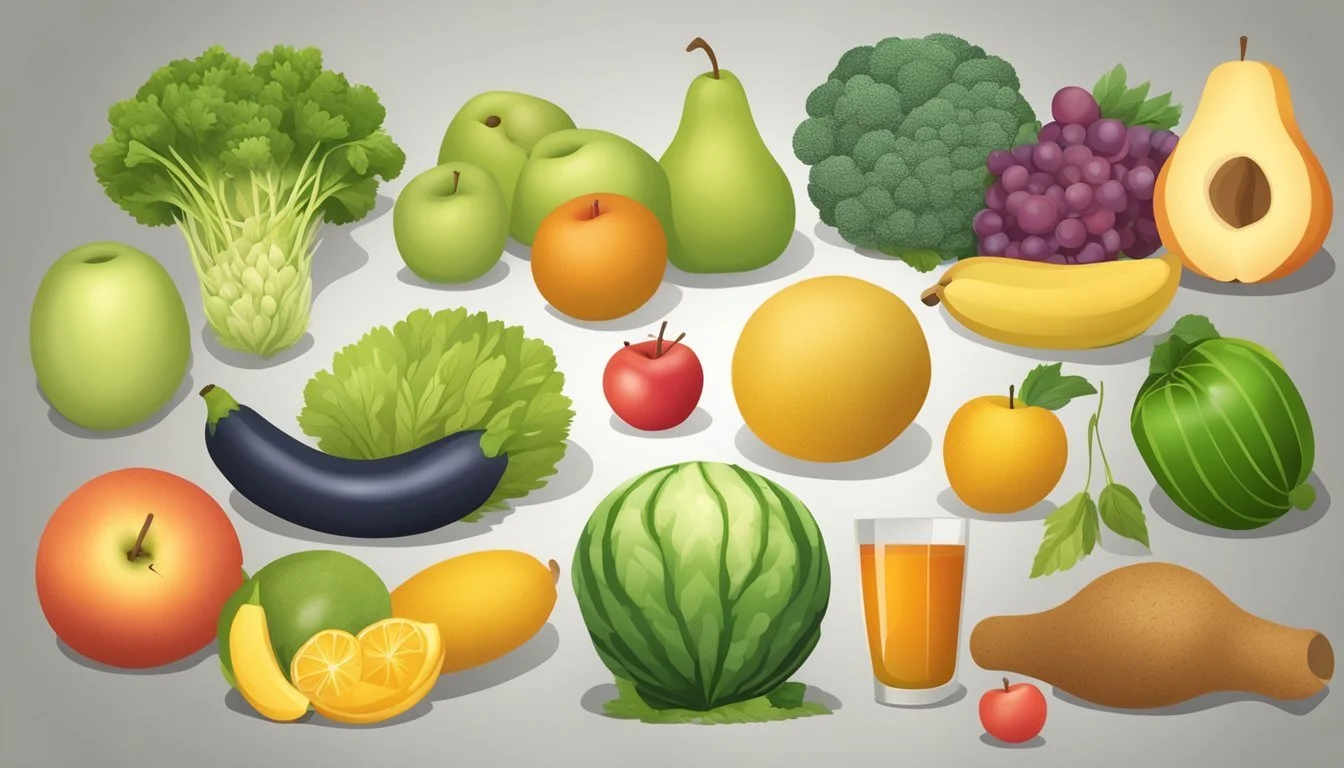The Role of Fiber in Digestive Health
Optimal Sources and Key Advantages
Dietary fiber plays a fundamental role in the maintenance of digestive health. As an indigestible part of plant foods, fiber contributes to various bodily functions, chiefly by aiding the digestive system. It enhances gut health and facilitates the smooth movement of food through the digestive tract, which can help prevent constipation. By adding bulk to the stool and absorbing water, fiber ensures that waste is excreted efficiently and comfortably.
In addition to its benefits for bowel regularity, fiber intake is linked with broader health implications. A diet rich in fiber can be protective against diseases like diabetes, heart disease, and certain types of cancer by regulating the body's use of sugars and contributing to a feeling of fullness, which helps in maintaining a healthy weight. With most people consuming less than the recommended 25 to 35 grams of fiber per day, there is a clear gap in the average diet.
The best sources of dietary fiber are plant-based, including whole fruits, vegetables, whole grains, legumes, nuts, and seeds. Integrating these foods into one's diet can significantly improve fiber intake and, in turn, support overall digestive function and general well-being. By focusing on whole and unprocessed foods, individuals can work towards meeting their daily fiber needs and enhancing their digestive health.
Understanding Dietary Fiber
Dietary fiber is a crucial non-digestible carbohydrate that plays a significant role in maintaining digestive health. It falls into two categories: soluble and insoluble, each with distinct benefits and sources.
Types of Fiber: Soluble and Insoluble
Soluble fiber dissolves in water to form a gel-like substance which can help lower blood cholesterol and glucose levels. Foods rich in soluble fiber include:
Oats
Peas
Beans
Apples
Citrus fruits
Carrots
Barley
Conversely, insoluble fiber does not dissolve in water. It helps material move through the digestive system and increases stool bulk, beneficial for those with irregular stools. Key sources of insoluble fiber are:
Whole-wheat flour
Wheat bran
Nuts
Beans
Vegetables, such as cauliflower and green beans
Both types of fiber contribute to a balanced diet and play a role in preventing certain diseases.
Sources of Fiber: Vegetables, Fruits, and Whole Grains
Vegetables, fruits, and whole grains are prime sources of dietary fiber. Incorporating a variety of these foods into meals ensures an adequate fiber intake:
Vegetables: Broccoli, spinach, and carrots
Fruits: Berries, pears, and apples
Whole Grains: Quinoa, brown rice, and whole wheat
Legumes, nuts, and seeds are also excellent fiber sources, often packed with additional nutrients like protein and healthy fats.
Role of Fiber in the Digestion Process
Dietary fiber aids the digestive process by absorbing water, which helps soften the stool and support regular bowel movements. It also serves as prebiotics, providing necessary nourishment for the beneficial gut bacteria. A diet with sufficient fiber has been linked to a lower risk of digestive tract diseases, including colon cancer and inflammatory bowel disease. Regular consumption of dietary fiber is essential for maintaining a healthy and efficient digestive system.
Health Benefits of Fiber
Fiber is an essential component of a balanced diet, known for its protective role against digestive health issues and its contribution to overall metabolic well-being. It is not only vital for bowel regularity but also plays a significant role in reducing the risk of various chronic diseases. A daily fiber intake of 25 to 35 grams is suggested for maximizing these health benefits.
Bowel Health and Regularity
Dietary fiber contributes to bowel health by adding bulk to the stool, which helps maintain regular bowel movements and prevent constipation. Soluble fiber, found in oats, legumes, and apples, absorbs water, which softens stool, while insoluble fiber, found in whole grains and vegetables, speeds the passage of food through the digestive system, reducing the likelihood of constipation.
Reducing the Risk of Chronic Diseases
Regular fiber intake is associated with a lower risk of several chronic diseases. Soluble fiber can help lower blood cholesterol by interfering with the absorption of dietary fat. It also helps to regulate blood sugar, which can reduce the onset of type 2 diabetes. High fiber consumption is linked to a decreased risk of heart disease and colorectal cancer.
Fiber's Impact on Weight Management
Fiber-rich foods tend to be more filling than low-fiber foods, which helps control appetite and can contribute to a healthy weight. By slowing the absorption of carbohydrates, fiber helps maintain stable blood sugar levels, which may prevent overeating and obesity, factors that can lead to type 2 diabetes and other health conditions.
Gut Microbiome and Immune System Enhancement
Fiber acts as a prebiotic, providing food for beneficial gut bacteria. The fermentation of fiber by these bacteria in the colon produces short-chain fatty acids that are thought to have protective effects. A robust gut microbiome supports the immune system and may enhance its ability to fend off infections and inflammation.
Fiber's Role in Inflammation and Infection Reduction
A diet high in fiber can have anti-inflammatory effects due to the action of gut bacteria on fiber, which leads to the production of compounds that may reduce inflammation in the body. This mechanism is thought to play a role in the prevention of diverticular disease and diverticulitis, lowering the risk of infection and complications in the digestive tract.
Specific Considerations for Fiber Intake
Understanding the distinctive dietary needs for fiber and its interactions with various health conditions is crucial. Different individuals require different amounts, and certain medical issues may necessitate a specialized approach.
Fiber Needs for Men and Women
Men and women have distinct fiber requirements due to differences in their digestive systems and nutritional needs. For men under 50, the recommendation is to consume 38 grams of fiber per day, whereas for women under 50, the recommendation is 25 grams per day. After age 50, the amount is reduced to 30 grams for men and 21 grams for women. Achieving these targets generally involves consuming a range of high-fiber foods such as whole grains, legumes, vegetables, and fruits. Fiber supplements can be used when dietary sources are insufficient, but must be integrated carefully as they can potentially affect the absorption of minerals like iron.
Fiber and Conditions like Irritable Bowel Syndrome and Diabetes
Individuals with conditions such as irritable bowel syndrome (IBS) and diabetes need to pay special attention to their fiber intake. For those with IBS, fiber can ease symptoms but must be adjusted according to tolerance, with a focus on soluble fiber from foods like oats and psyllium. In contrast, insoluble fiber found in whole grains can sometimes worsen symptoms.
People with diabetes are encouraged to incorporate fiber into their diet to help regulate blood sugar levels. The high-fiber diet slows down the digestive process, allowing a more gradual release of glucose into the bloodstream, which can improve insulin sensitivity and glycemic control. It's essential that both IBS and diabetic patients discuss their fiber intake with a healthcare provider to create a tailored plan that suits their specific health needs.
Incorporating Fiber into Your Diet Effectively
To optimize digestive health, one should concentrate on regularly consuming a variety of high-fiber foods across meals. By planning ahead and opting for smart supplementation, individuals can effectively meet their daily fiber intake goals.
Choosing High-Fiber Foods
When selecting foods rich in dietary fiber, one should aim for a variety that includes fruits, such as apples (with skin) and pears, vegetables, and legumes, including beans. Whole grains like oats are also excellent sources, while nuts like almonds offer added nutritional benefits. It's pertinent to note the fiber content on nutrients labels, as it contributes to the overall carbohydrate count, yet is not fully absorbed, leading to fewer calories than other carbohydrates.
Fruits (e.g., pears, apples): 4-5 grams of fiber per medium-sized fruit
Vegetables: 2-3 grams per 1/2 cup serving
Beans: 6-9 grams per 1/2 cup cooked serving
Oats: 4 grams per 1/2 cup uncooked serving
Almonds: 3.5 grams per ounce
Planning Fiber-Rich Meals Throughout the Day
Ingesting fiber-rich foods requires consistent effort. A well-balanced diet should include fiber at every meal, which may involve integrating fruits like pears and apples into breakfast cereals or consuming vegetables with lunch and dinner. Beans can be a part of either main meals or snacks. One should balance fiber intake with adequate water consumption to promote better fiber absorption and gastrointestinal function. Starting the day with a bowl of oats can set a positive tone for the rest of the day's meals.
Breakfast: A bowl of oatmeal topped with sliced apples and almonds
Lunch: A mixed vegetable salad with a side of beans
Dinner: An entrée that includes a generous portion of vegetables
Understanding Fiber Supplements and Alternatives
In cases where dietary adjustments are insufficient or if one faces challenges in consuming fiber-rich foods, fiber supplements can be an option. Supplements like oligosaccharides or fructooligosaccharides offer a convenient alternative to fulfill dietary requirements without adding significant calories. However, they should complement, not replace, whole food sources of fiber. It is critical to introduce any supplements gradually to prevent digestive discomfort and to ensure a mixed intake of soluble and insoluble fiber for optimal benefits.
Recommended introduction of fiber supplements: Gradually over several weeks
Examples of fiber supplements: Oligosaccharides, fructooligosaccharides
Note: Maintain adequate hydration when using fiber supplements
Adverse Effects of Excessive Fiber Intake
Though fiber is essential for maintaining a healthy digestive system, consuming it in excessive amounts can lead to adverse effects.
Potential Risks and How to Mitigate Them
Bloating and Gas: A common consequence of excessive fiber intake is bloating, characterized by a feeling of fullness and discomfort in the abdominal area. This can be accompanied by increased flatulence. To mitigate these symptoms, one should increase fiber consumption gradually, allowing the digestive system to adjust.
Cramping: Excessive fiber can also cause abdominal cramps, stemming from digestive stress. This discomfort is often due to the body's difficulty in digesting large amounts of fiber at once. Introducing fiber slowly into the diet and consistently drinking water can help ease cramping.
Digestion Disruptions: Although fiber aids in digestion by helping food move through the digestive tract, too much fiber can disrupt this process, leading to constipation or even intestinal blockage. Maintaining a balanced intake of soluble and insoluble fiber, staying hydrated, and staying active can aid in preventing these digestive issues.
To reduce these negative effects, individuals should be mindful of their fiber sources and adhere to recommended daily intake guidelines — typically 25 grams for women and 38 grams for men. If symptoms persist, seeking advice from a healthcare provider is recommended.
Conclusion
Incorporating fiber into one's diet is a straightforward and effective strategy for enhancing digestive health. Rich in nutrients, fiber acts as a catalyst for maintaining regular bowel movements and has been linked to a reduction in the risk of certain diseases. Sources like fruits, vegetables, whole grains, and legumes are not only abundant in fiber but also include a host of other beneficial compounds that collectively support overall health.
The inclusion of dietary fiber should be thoughtful, aiming for a balance that prevents discomfort such as bloating and gas often associated with sudden high intake. A gradual increase allows the digestive system to adjust, and the intake of fluids should concurrently rise to aid fiber's benefits.
Key Benefits of Fiber Sources of Fiber Enhances bowel regularity Fruits Aids in weight management Vegetables Lowers risk of chronic diseases Whole grains Supports blood sugar control Legumes
As consumers aim to optimize their intake, they should consider a variety of sources to ensure a wide spectrum of nutrients accompanies the essential fiber. The prevalent recommendation underscores that a balanced and moderate approach is quintessential. It's not about one superfood, but rather a well-rounded diet rich in fiber that fortifies digestive health and contributes to overall wellbeing.



